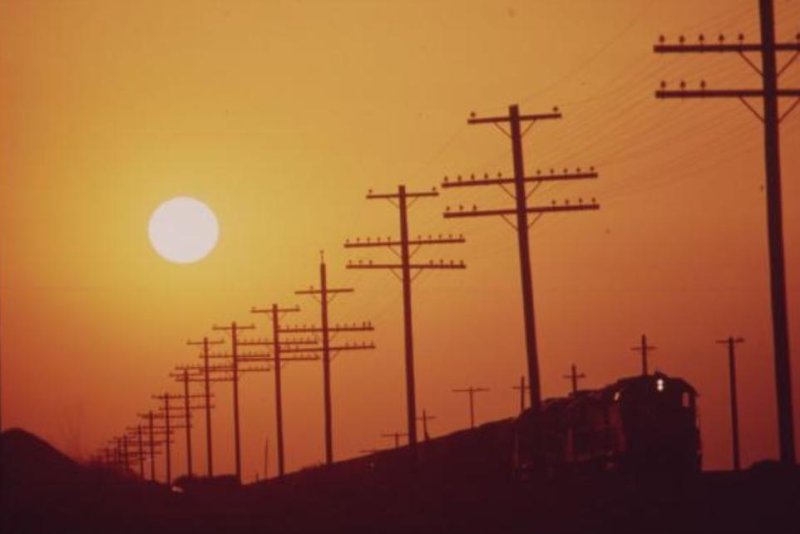Workers are installing millions of new solar panels that will soon be connected to Texas' grid to supply the power-hungry state with more renewable energy. File Photo by Charles O'Rear/EPA
IRVING, Texas, Oct. 2 (UPI) -- Wind power production is setting records in Texas, but an energy revolution is expected from a project to develop utility-scale solar electricity that will help double the state's sun-harnessing capabilities over the next two years and ease demands on an often-overloaded power grid.
Those plans include Misae I and II, two of the largest utility-scale solar projects in the United States, and increased production of utility-scale batteries -- all of which has the potential to substantially increase the marketability of renewable energy.
Experts say generating power from a mix of fossil fuels and renewable energy will be crucial for a state that continually requires more electricity to meet daily needs, particularly during hot Texas summers.
For most of the past decade, renewable energy investment dollars have been funneled into wind power, a corner of the market that's doubled capacity from from 9,400 megawatts in 2010 to more than 22,000 megawatts this year, according to the Electric Reliability Council of Texas. By 2021, the state could add more than 14,000 additional megawatts of wind power to the state grid.
For the first time in history, production of wind power topped coal power in Texas over the first six months of 2019. But the trouble with wind, some experts say, is there often isn't enough during the peak summer heat.
In August, wholesale electricity prices soared to more than $9,000 per megawatt hour several times because excess capacity, or reserve margin, fell below predetermined thresholds. Experts note that if just one major natural gas plant had gone offline during the crisis, ERCOT would have been forced to implement rolling blackouts -- a last-ditch effort utilities use to avert overload and a total blackout.
"When we reach conditions in which resources are scarce compared to customer demand, all available resources are online, and we get to the point where the amount of unused capacity falls below the 3,000 megawatt cap," ERCOT's senior director of system planning Warren Lasher said. "That reflects that scarcity in the wholesale market price."
Most Texans in deregulated areas were insulated from price hikes because their electric rate is locked in. But residents who buy power wholesale were hit hard, with electric bills that quickly totaled thousands of dollars.
Experts say peak demand is growing at up to 1,500 megawatts per year, driven mostly by population growth in major cities. Another driver is wattage needed to power the oil and gas shale boom in West Texas. Lasher said hydraulic fracking, which breaks up shale rock to release oil and gas, uses large amounts of electricity.
Solar power's time to shine
Texas' solar power capacity has grown from just 15 megawatts in 2010 to more than 1,800 megawatts this year. Officials say that by 2021, an additional 5,400 megawatts of utility-scale solar power will be added to the ERCOT grid, which powers most of the state. Another 3,500 megawatts have signed interconnection agreements with ERCOT, but don't yet have financial backing.
"We are seeing a significant growth in solar resources," Lasher said. "There's a lot of interest in solar. There's more solar availability and it's more consistent across the day on a day-to-day basis" than wind.
On the plains of the Texas panhandle, about 230 miles northeast of Dallas-Fort Worth, workers are installing millions of new solar panels that will soon be connected to the grid to supply power-hungry Texas with clean, renewable energy. The project, developed by Misae Solar Parks, will be built in two phases and could start producing solar energy by the end of the year.
The prospect of producing so much solar power in rural Texas has attracted investors from Denmark.
"There are many investors that are looking for these large projects," radiologist-turned-solar- developer Miguel Alejandro Oneto said. "It's very difficult to put together a project of this size -- it involves 19 tracts of land, so you're dealing with multiple owners. I had full faith in these projects, so I ended up purchasing the land."
Oneto said the second phase involves a more ambitious solar farm to generate power that can supply nearly 130,000 homes when it's connected to the grid in 2021.
Together, the projects will produce more than 1 gigawatt of electricity on 5,000 acres, from more than 2.6 million solar panels.
Rise of the batteries
The rise of electric vehicles -- from Tesla Motors, in particular -- has driven down the cost of lithium ion batteries. And some developers now use them to boost electricity grids.
Utility-scale battery storage has grown from 36 megawatts in 2012 to more than 100 megawatts this year, and future plans show another 60 megawatts could be added -- room for growth that's even lured California-based Tesla to partner with ERCOT in the development.
The goal, they say, is to combine the intermittent nature of renewable energy with batteries and allow artificial intelligence to decide when it's best to charge the battery and when to move the stored power to the grid.
Experts say the "holy grail" would be the ability to harness wind power at night to charge the batteries, rather than dispensing it onto the grid at negative prices. The battery could then send the power to the grid when demand is higher, Lasher said. The same goes for solar power from the morning sun -- storing the power until the afternoon when demand soars.















